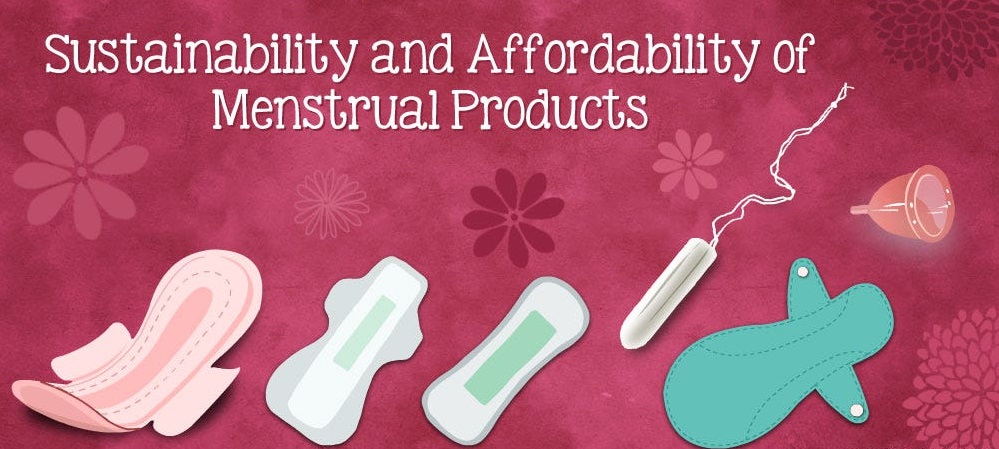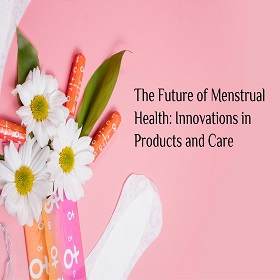
Menstrual health is undergoing a revolutionary transformation, driven by advancements in smart technology and a growing emphasis on sustainability. These innovations in period care are effectively addressing common challenges such as irregular menstruation, heavy menstrual bleeding, menstrual cramps relief, and amenorrhea. This shift not only enhances comfort and convenience but also promotes eco-friendly choices.
What is Menstrual health?
Menstrual health is a state of total physical, mental, and social well-being in relation to the menstrual cycle, and not merely the absence of disease or bodily defect. Menstrual cycles are different from one person to another, usually between 21 to 35 days apart, with the duration of bleeding between 2 to 7days. During the early years of menstruation, the cycles tend to be longer, but as the years go by, cycles tend to shorten and become regular.
The future of menstrual health is changing at an accelerated pace with advancements in product, technology, and overall expansion in sustainable and personalized care. Some of the major trends in the future of menstrual health are:
Sustainable Menstrual Products: A Greener Future for Period Care
In today’s world, sustainability has become more than a trend—it’s a necessity. Period care is no exception. Eco-conscious innovations are transforming how we manage our menstrual health, offering alternatives that are not only better for the planet but also gentler on our bodies.
Eco-Friendly Menstrual Products
Reusable Products: Menstrual cups, reusable pads, and period underwear are becoming popular because of the environment and being cost-effective. These products provide an eco-friendly option to single-use pads and tampons.
Biodegradable Options: Companies are creating biodegradable tampons and pads using organic cotton or plant-based materials to minimize environmental waste.
Customized Period Care
Menstrual Tracking Apps: Sophisticated period-tracking apps leverage AI to forecast menstrual cycles, fertility windows, and even health conditions based on hormonal changes. This tailored method empowers women to better control their cycles.
Hormonal Data and Wearables: Certain wearables track hormonal changes now, enabling real-time monitoring of cycles and associated symptoms, giving a more comprehensive picture of menstrual health.
Period-Positive Education and Advocacy
Destigmatization: Cultures are opening up more to talking about menstrual health, and shattering taboos. This change is driving the creation of educational programs and support networks that promote improved menstrual hygiene and self-care.
Policy Changes: Most nations are heading towards menstrual equity, with policies for free or subsidized period products in schools and public places. Scotland has already taken the lead in making free products available to all women.
Tech-Integrated Menstrual Health
Smart Menstrual Products: The innovations such as Bluetooth-connected menstrual cups monitor fluid amount and offer women information about their flow as well as warnings when a change is needed.
Telehealth for Menstrual Issues: Telemedicine sites are facilitating women’s access to gynecologists and menstrual health professionals, even for those in rural communities, and providing access to required care and consultations.
Innovations in Pain Relief
Non-invasive Devices: Wearable devices that administer heat therapy or electrical stimulation are being designed to assist in easing menstrual cramps, providing relief without drugs.
Menstrual Supplements: Technological advancements in nutraceuticals are contributing to the development of specialized supplements that will restore hormonal balance and ease PMS or period pain.
Cultural and Gender-Inclusive Menstrual Products
Gender-Inclusive Products: Increasingly, menstrual products are being made gender-inclusive, acknowledging the needs of non-binary and trans people who menstruate, with gender-neutral packaging and marketing
Menstrual Health and Mental Well-being
Mental Health Integration: Studies are now more directed towards the connection between menstrual health and mental health, with an awareness of conditions such as PMDD (Premenstrual Dysphoric Disorder). Technology and innovations in mental health care that are specifically designed for menstrual cycles are also being developed.
Smart Technology in Menstrual Health
Smart Menstrual Cups
Smart menstrual cups, like the LoonCup, are equipped with sensors that monitor menstrual flow, color, and volume. These devices sync with smartphone apps to provide real-time data, helping users track their cycles and detect anomalies. Such technology is particularly beneficial for those managing irregular periods or conditions like amenorrhea, as it offers insights into hormonal health and cycle patterns.
Menstrual Tracking Apps
Modern apps go beyond simple period tracking. They analyze data to predict ovulation, monitor symptoms, and provide personalized health recommendations. For individuals experiencing heavy menstrual bleeding or irregular cycles, these apps can be instrumental in identifying patterns and informing medical consultations.
Wearable Pain Relief Devices
Devices like Livia and Welme offer drug-free menstrual cramps relief through Transcutaneous Electrical Nerve Stimulation (TENS) technology. These portable gadgets deliver gentle electrical pulses to block pain signals, providing immediate relief without medication.
Addressing Menstrual Health Challenges
Irregular Periods and Amenorrhea
Amenorrhea is when a woman fails to get her menstrual period. There are two types of amenorrhea: primary and secondary. Primary amenorrhea is when an individual over the age of 15 has never gotten their first period. Secondary amenorrhea occurs when an individual fails to get a period for over three months.
What are the signs of amenorrhea?
The primary sign is not having periods. Other signs vary depending on the cause. A woman might feel:
Hot flashes.
Leakage of milk from nipple
Dryness of the vagina.
Headaches.
Changes in vision.
Acne.
Facial and body hair growth.
Smart menstrual products and tracking apps provide valuable data for individuals experiencing irregular periods or amenorrhea. By monitoring cycle patterns and symptoms, users can identify potential health issues early and seek appropriate medical advice.
Heavy Menstrual Bleeding
Some women experience heavy or longer-than-usual menstrual bleeding. Heavy menstrual bleeding is also known as menorrhagia. Heavy menstrual bleeding is a common issue. But the majority of women don’t have enough blood loss to qualify it as heavy menstrual bleeding.
Bleeding can occur between periods or earlier or later than normal in a woman’s cycle. That is called abnormal uterine bleeding or irregular menstrual bleeding.
Heavy menstrual bleeding involves a heavy flow and cramping that makes it more difficult to perform your normal activities.
Heavy menstrual bleeding symptoms may include:
Needing to change a pad or tampon every hour for several hours in a row.
Wearing double sanitary protection to manage your menstrual flow.
Waking up to change sanitary pads or tampons.
Bleeding for longer than seven days.
Passing clots larger than a quarter.
Restricting activity due to heavy menstrual flow.
Experiencing weakness, exhaustion, or shortness of breath due to blood loss.
For those dealing with heavy menstrual bleeding, high-absorbency menstrual cups and period underwear offer reliable protection. These products reduce the need for frequent changes and provide comfort during heavy flow days.
Menstrual Cramps Relief
“Dysmenorrhea” is the medical name for crampy menstrual periods. It occurs because a woman’s uterus contracts to shed its lining. The pain usually starts just before a woman’s period and goes away after a few days. Primary dysmenorrhea is recurrent pain with no known cause. Secondary dysmenorrhea is caused by conditions such as endometriosis.
What are the signs of painful menstrual cramps?
If you experience painful periods, you might feel:
Aching, throbbing pain in your belly (pain may be bad at times).
Sense of pressure in your belly.
Pain in your hips, lower back, and inner thighs.
Other symptoms such as nausea, dizziness, and headaches.
In most instances, the pain starts in the 24 to 48 hours leading up to your period and fades within 48 hours of receiving your period.
Wearable TENS devices offer a non-invasive solution for menstrual cramps relief. By targeting pain at its source, these gadgets provide effective relief without the side effects associated with medications.
The Future of Menstrual Materials
The menstrual product landscape has evolved significantly in recent years, with new sustainable innovations emerging regularly. However, if women continue to have access only to disposable sanitary pads, the demand for these products will persist—often without the benefit of informed choice or awareness of hygiene best practices.
This limited knowledge is largely the result of deep-rooted social taboos that still surround menstruation, making open conversations about alternatives difficult for many.
To shift the focus from single-use pads and foster real choice, it’s essential to provide complete and unbiased information about the full range of menstrual materials available today—from reusable options like menstrual cups and period underwear to biodegradable, organic products.
Breaking the silence around menstruation is crucial for achieving period equity—a future where every woman, regardless of her background or circumstances, can manage her periods safely, hygienically, and sustainably.
Conclusion
The integration of smart technology and sustainable practices in menstrual care is revolutionizing the way individuals manage their periods. By addressing specific health challenges and promoting environmental responsibility, these innovations are paving the way for a more informed and empowered approach to menstrual health.
FAQ’s for Fighting Pediatric Pain: New Approaches in Pain Management in PICU
Smart menstrual products are tech-integrated solutions like Bluetooth-enabled menstrual cups or wearable pain relief devices that track flow, detect anomalies, and provide real-time insights into menstrual health.
Period tracking apps use AI and data analysis to monitor cycles, predict ovulation, and offer personalized recommendations, helping users understand irregularities and manage symptoms more effectively.
Sustainable menstrual products include reusable options like menstrual cups, period underwear, and cloth pads, as well as biodegradable pads and tampons made from organic or plant-based materials.
Yes, smart menstrual cups are designed with medical-grade materials and offer additional benefits like flow tracking. They are safe when used as directed and can improve cycle awareness.
Reusable products are eco-friendly, cost-effective in the long run, reduce landfill waste, and often contain fewer chemicals, making them gentler on the skin.
Yes, devices like TENS machines (e.g., Livia, Welme) use gentle electrical pulses or heat therapy to block pain signals and provide drug-free relief from menstrual cramps.
Amenorrhea is the absence of menstruation. Smart tracking tools and wearables can help monitor hormonal changes and menstrual patterns, assisting in early diagnosis and medical consultation.
Switching to sustainable menstrual products reduces plastic waste, lowers carbon footprints, and helps conserve resources used in manufacturing disposable products.
High-absorbency menstrual cups, reusable pads, and period underwear are effective for managing heavy flow, providing longer protection and reducing frequent changes.
Open, inclusive education helps break taboos, encourages informed choices, promotes hygiene, and supports menstrual equity, allowing everyone to manage their periods with dignity.




